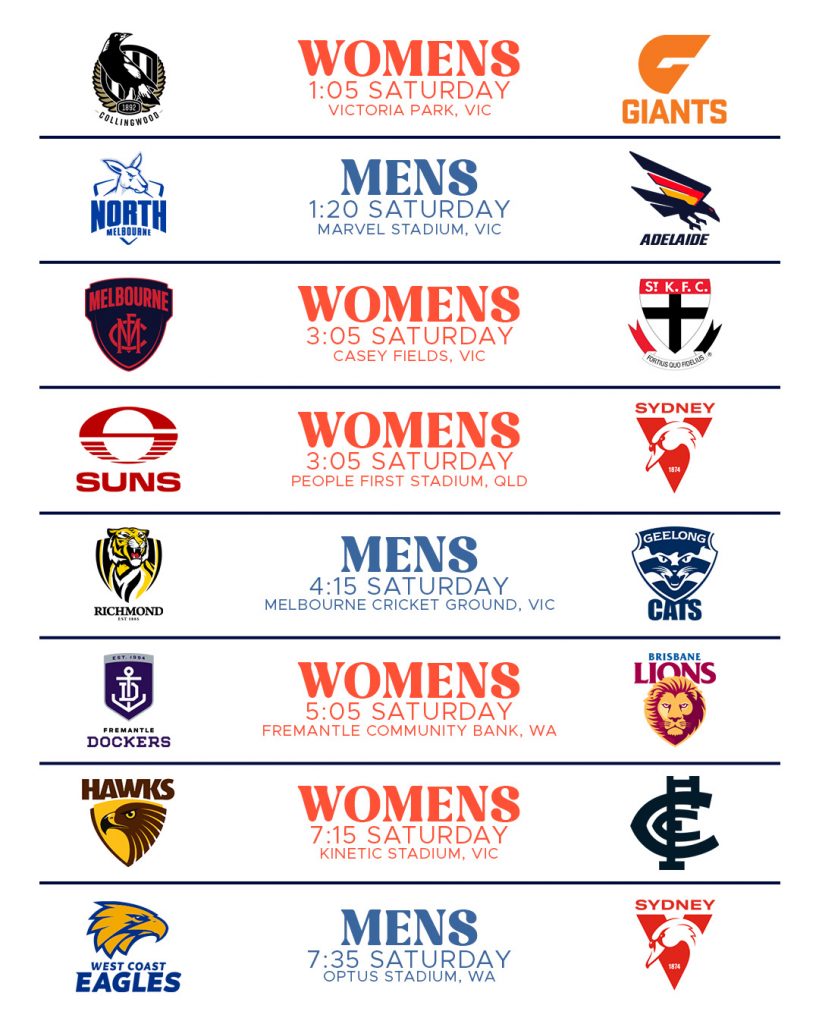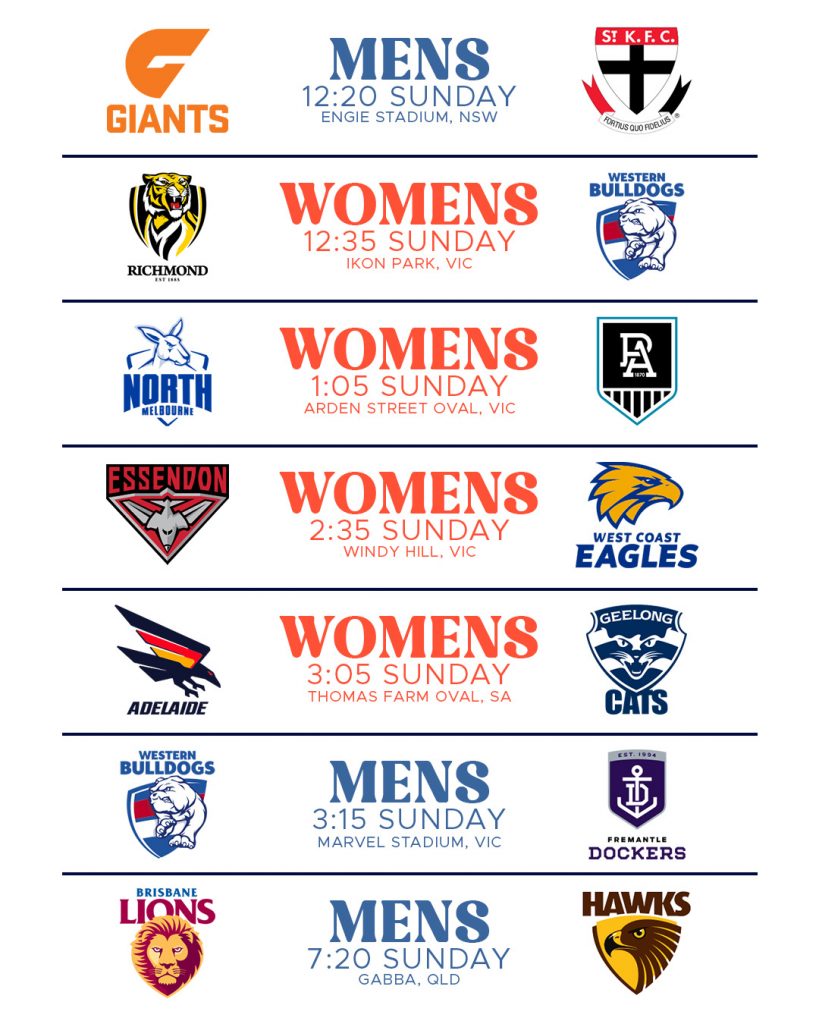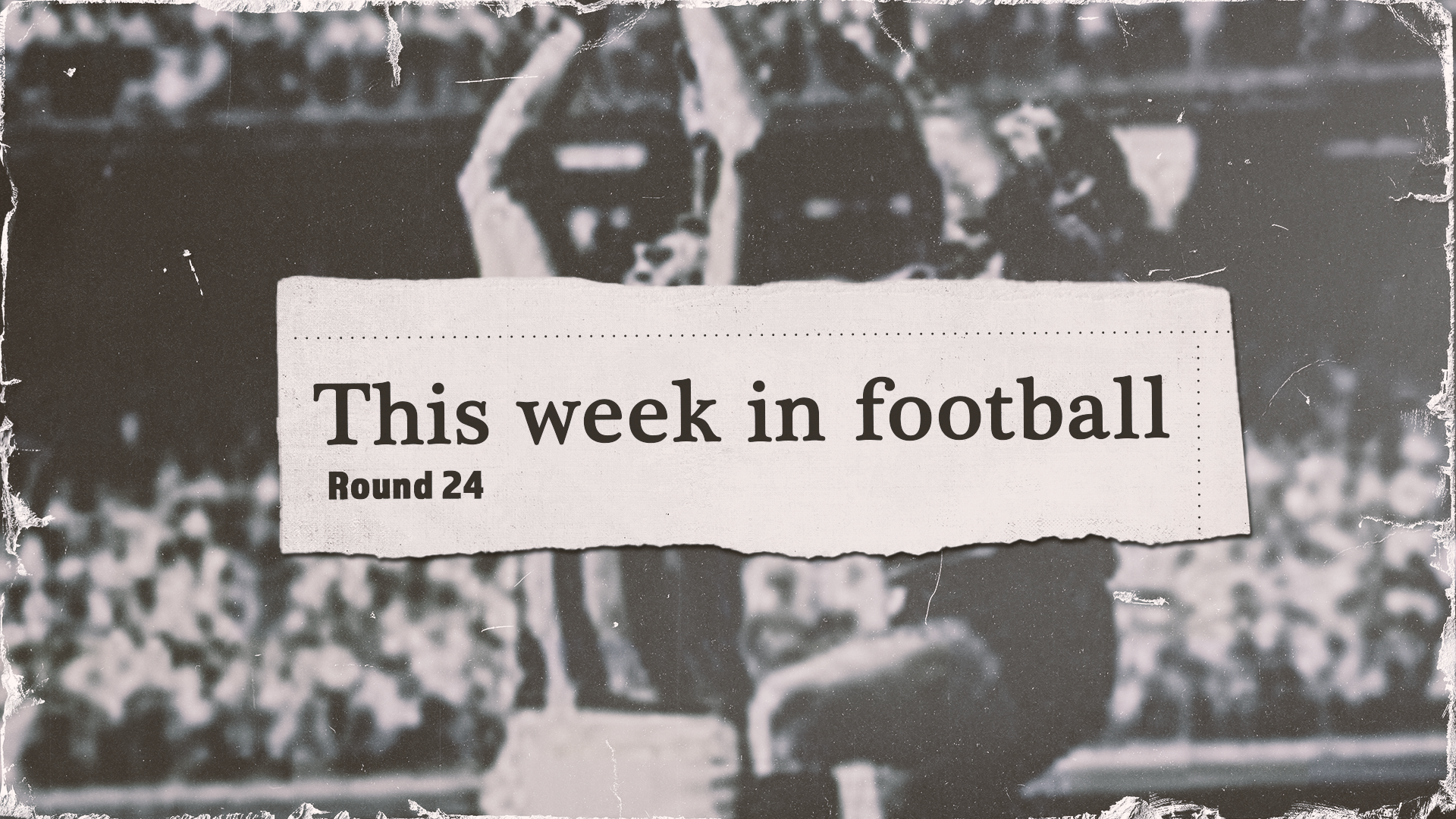This Week In Football is a collection of some of the best in football currently outside the walls of AFL clubs or broadcasters. Each week a curated grab bag from regular contributors and special guests will provide insight into and beyond the game on subjects of their choosing. For more about our contributors, click here.
Banner images by Polly Porridge of the True Bloods Podcast. Check out her other design work.
Before the Bounce
This upcoming round is about to see the maximum amount of elite footy played in one week in the modern football era.
Nineteen games of elite football will take place in a seven day period out to Wednesday’s makeup game between the Suns and Essendon. With the compressed 2020 Covid season not reaching such levels, the last time top level footy saw so much action was probably in the state league era when three states saw top level footy at once.
It all gets a bit difficult to keep track of, particularly as the AFLM and AFLW continue to exist, despite some level of web and app integration, in somewhat parallel media and fixturing spaces. Look up what games are on when, and chances are you’ll only see half of them listed.
Luckily, friend of TWIF Polly Porridge has done something the AFL should have already done via its official app. Polly has put together a match listing for all of the weekend’s games with all AFLW and AFLM starting times with all games listed chronologically (all times AEST):


It’s a whole lot of footy – fifteen games in two days – for everyone.
Hope you are ready for Peak Football.
This Week in Football we have:
Breaking down score involvements and score launches
Andrew Whelan / WheeloRatings.com
For my first TWIF article I will explore score involvements and score launches. What are they and who are the leaders this season?
Here are the definitions from the Champion Data glossary:
- Score involvement: Number of scoring chains where a player was involved with either a disposal, hitout-to-advantage, kick-in or knock-on. If a player has two disposals in the same scoring chain, he is credited with one score involvement.
- Score launch: Scoring chains launched by an intercept possession, free kick, hitout-to-advantage or clearance.
- Scoring chain: Includes all disposals and possessions for the scoring side that occur between the score launch and the actual score. The chain can only be broken by either the opposition gaining possession of the ball or a stoppage.
Working back from the score itself, the scoring chain begins at the most recent stoppage, kick-in or when the scoring team last gained possession from the opposition. Only a stoppage or a change in possession breaks the chain – a spoil from the opposition does not break the chain, nor does an ineffective disposal from the scoring team if possession is retained.
For scoring chains that start with a kick-in or an intercept possession, the score launch will be credited to the player taking the kick-in or winning the intercept possession (which may be a free kick). For scoring chains starting with a stoppage, if there’s a hitout to advantage AND no opposition player took possession of the ball pre-clearance, the hitout to advantage will be the score launch, otherwise it will be the player winning possession pre-clearance and starting a chain of unbroken possession.
Scores, score assists and (most) score launches are included in the count of score involvements.
Interesting side note – if a scoring chain starts with a free kick and a teammate takes the advantage, the player winning the free kick gets a score launch but does not get credited a score involvement unless they have another involvement later in the chain.
One correction I would make to the score involvement definition is changing the second sentence to “if a player has multiple involvements in the same scoring chain, he is credited with one score involvement.” A player with a hitout-to-advantage and a disposal in the same chain is only credited with one score involvement.
To provide a visual example of scoring chains, the following chart shows all Adelaide’s score involvements against Collingwood in Round 23. Each point represents a disposal, hitout-to-advantage, kick-in, knock-on or spoil, in chains resulting in a score. The tooltip for each data point provides additional detail of their specific involvement.
Here is a summary of all non-score score involvements by type of involvement since the start of 2021.
And here are the types of involvements launching scoring chains.
Who’s leading the score involvements this season?
Ed Richards and Nick Daicos are first and second in total score involvements this season with a similar breakdown of score launches, score assists, scores, and other score involvements. Next is Jeremy Cameron with two thirds of his score involvements being his own score. Rounding out the top five is Hugh McCluggage, who leads the league in score assists, and Christian Petracca, who’s number one in the AFL for average score involvements since 2021.
Score assists have been estimated and will be the subject of a future article.
What about score launches?
Max Gawn is leading the way in score launches averaging a career high 4.27 per game – the second highest season average since 2012, behind Todd Goldstein in 2015. Witts and Xerri aren’t far behind, averaging 4.15 and 4.05 per game, respectively. Max has launched 17 scores from intercept possessions this season, 32 from hitouts to advantage, and 45 from winning possession pre-clearance.
Here are the leaders this season.
Diving into the first week of 2025 AFLW
Emlyn Breese / CreditToDuBois.com
With the first week of AFLW in the books it’s worth spending some time looking at what we can get out of the early data available.
I’ve started off by trying to identify score sources. This is relatively easy to get for the Men’s competition, but faces some extra challenges in the Women’s. This is still a work in progress, so take with a grain of salt. Because the sources are new, there’s no prior year comparison available.
Overall we can see scores from kick-in even more negligible in AFLW than AFLM, and we also see a bigger prevalence of scores from turnover.
Let’s now look at it on a game-by-game basis:
Port are the only team to have scored a goal from kick in, with Katelyn Pope’s last quarter goal.
Essendon and Melbourne had the most scoring events from turnover, while the Sydney v Richmond match saw both teams scoring as many times from stoppage as from turnover.
Winning the ball by degrees
Cody Atkinson
All teams want to do two things as much as humanly possible.
- Win the ball
- Score
If you’ve got the ball you can score, and the other team can’t. And – spoiler alert – if you score more than the opposition you win.
Someone get me on the line to eighteen different clubs, this is groundbreaking stuff.
But not all won ball is the same. Some is won hard, and some is loose. Some leads to territory gains, others are turned over right away. Importantly – and linking to point 2 above – some ground ball wins lead to actual scores.
This year Tom Green has won more ball on the ground than any other player. He’s averaging 10.1 ground ball gets per game. If you break it down further, 3.4 of those are classified as “hard ball gets” and the remaining 6.7 as loose ball gets.
This is where on the ground he has won them this year.

Green follows the ball – and the contest – around the ground. While there’s an expected cluster in the middle, there’s also a fair bit of action on all four corners of the deck. Note – the ground shape is normalised for the dimensions of the MCG – hence some of the boundary issues.
If you break it down by scores generated by ground ball wins, something interesting emerges.

That big cluster in the middle all but disappears. The Giants have struggled to turn Green’s inside ball into points from the middle, despite everything they’ve tried. The Giants are firmly mid-pack for points from stoppages and points differential from that source. That means a lot of Green’s work either hasn’t gotten teammates into space, or the chain of control has broken down towards goal. It’s been a longstanding issue for Adam Kingsley, and one that he needs to resolve to get the most out of the best ballwinner in the league.
As mentioned above, there are two broad types of ball to be won. The first requires physical pressure and contact. This year, no player has won more hard ball than Tom Liberatore.

Like Green, Libba follows the ball around the ground when it comes to rest. The second generation Dog has an even more pronounced cluster in the middle, but has a heavy lean to the defensive side of the centre square. That hints to his positioning at centre bounce – at the defensive sweeper side. That job is difficult, and requires balancing winning ball and preventing opposition sides from sweeping through the contest. Few can manage that balance well – let alone winning so much ball themselves.
Most ground balls are classified as loose balls however. They happen at stoppages, but also often occur in general circumstances around the ground. This year two-time Brownlow Medalist Lachie Neale is leading the way.

Neale’s loose ball wins are less focused on the middle. It’s a testament to his endurance ability and skill in reading where the play is likely to unfold. Neale has a nose for the ball, and to predicting where it will go before it gets there.
No matter if it’s hard or loose, straight from a ruck tap or occuring in the middle of a transition chain, every team needs good ball winners. Green, Liberatore and Neale have been the best three this year. All three are reasons that their sides are firmly in the race for September glory.
How does Nasiah Wanganeen-Milera’s reported contract value stack up?
Sean Lawson
With reports saying Nasiah Wanganeen-Milera has just become the first player to earn $2 million in a single season, it’s a great time to try to put that into context and see how it compares to the big contracts of years gone by.
AFL contract reporting is a very nebulous activity. Reporting around individual player contracts is often vague, misleading, and subject to spin by reporting parties.
We do know a few things for sure – the salary cap value, the minimum pay for draftees, the rough spread of player contracts.
We know as of last year the typical club senior list would have been structured roughly as below, with an average of two players on over $1 million a year. This figure is very likely to rise to at least three per team on average in 2026.
We know that, on average, the top three players might earn about 20% of the salary cap, and the top 6 players around one third of the salary cap.
We also know that cap keeps going up:
The salary cap is roughly double what it was in 2012, triple what it was in 2004, and just much larger than the 1990s. The cap growth has outpaced inflation and, in the case of some long deals, even left players behind as the cap grew around them. The AFL-AFLPA CBA has a ratchet clause for insertion in standard player contracts, but league sources indicate that insertion is not universal across the board.
That leaves the unknowns. Even when news reports appear to carry fairly specific contract values for a player, often this number will be under or over what they actually earn:
- Agents have incentive to inflate contract values to bolster their percieved effectiveness.
- Clubs have incentives to hide money or to deflate figures to keep other players happier.
- The press like round numbers, and sensationalised reporting presenting upwardly rounded multi year payments as a single number.
- Some contracts have guaranteed and non-guaranteed money, with bonuses based on honours earned or game benchmarks.
For historical contracts, extra payments outside the cap are obviously a difficult to identify factor. The Anthony Koutoufides contract reported in 2003 of $4m over 5 years turns out according to his agent at the time to have also involved 750k in under the table payments.
Warwick Capper’s Brisbane Bears deal, already massive, was supplemented by valuable gifts from Christopher Skase such as a $200k vase and a clothing shop.
So there’s a lot of caveats here, and now we can plough ahead, remembering all this should be taken with many grains of salt:
As it turns out, Wanganeen-Milera’s two year contract at the Saintswill be roughly on par with the payment of Lance Franklin and Dustin Martin in terms of cap hit in the first year of the deal.
Both of those were much longer deals with the amount of money managed across 9 and 7 years respectively, during which times the cap increased. At times both of those players may have been forming a smaller or larger share of the cap.
For Wanganeen-Milera and the Saints, the cap hit is shorter term, which means less flexibility to spread the cap hit, but much more for the Saints to manage other cap space and recruitment.
One player filling 10% of the salary cap may not be especially unreasonable considering we know that the top 3 players at the average club might get 20% and the top 6 might get over a third. The Saints have reportedly used salary cap banking in previous years to open up space for their current recruiting decisions, and the ability to defer other longer contracts into the future also exists.
But make no mistake, the AFL’s (probably) first two million dollar man is being paid handsomely for his universally acclaimed talents, on par with a couple of the 2010s’ biggest superstars relative to the salary cap of the day.
Around the Grounds
- Gemma Bastiani on the W Show makes the case for recording an inside-30 stat for AFLW after the Crows showcased a lot of deep ineffective inside-50s in their surprise loss to the Saints.
- Marnie Vinall’s ABC article about the impact of homophobia in sport is essential reading in light of the current situation.

Leave a Reply